Hollingbourne, Kent
Up to 1834
A workhouse operated at Lenham from around 1730 (Hitchcock, 1985).
A Parliamentary report of 1777 recorded parish workhouses in operation at Hollingbourne (with accommodation for up to 40 inmates), Boxley (36), Lenham (40) and Sutton Valence (20).
A building known as the Cloth Hall, on North Street, Headcorn, is said to have served as the parish workhouse.
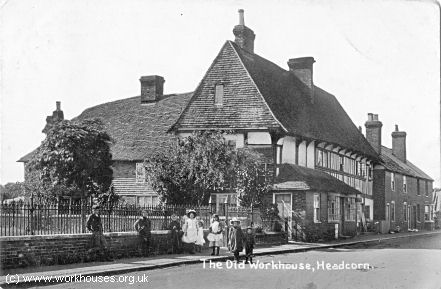
Headcorn 'Old Workhouse', c.1920.
© Peter Higginbotham.

Headcorn 'Old Workhouse', c.1920.
© Peter Higginbotham.
A cottage on Sittingbourne Road, Detling, was the parish's workhouse in the early 1800s. It is now a private residence known as Workhouse Cottage.
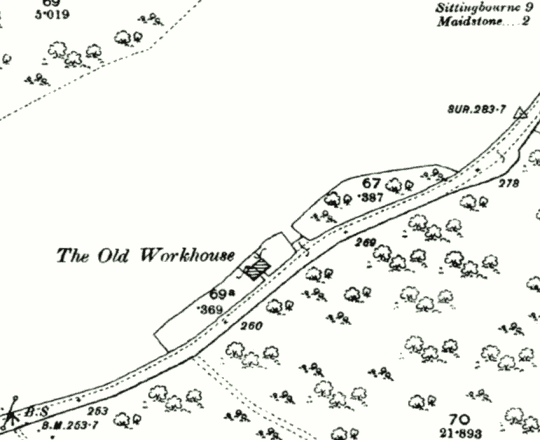
Detling workhouse site, c.1896
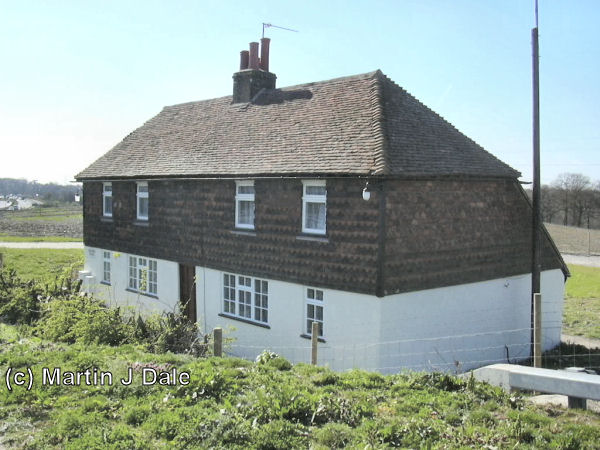
Workhouse Cottage, Detling, 2003.
© Martin J Dale.
After 1834
The Hollingbourne (frequently spelled Hollingbourn in older documents) Poor Law Union officially came into existence on 12th October 1835. Its operation was overseen by an elected Board of Guardians, one representing each of its 23 constituent parishes as listed below:
County of Kent: Bicknor, Boughton Malherbe, Boxley, Bredhurst, Broomfield, Chart next Sutton Valence [Chart Sutton], Debtling [Detling], Frinsted, Harrietsham, Headcorn, Hollingbourne, Hucking, Langley, Leeds, Lenham, Otterden, Stockbury, East Sutton, Sutton Valence, Thurnham, Ulcombe, Wichling, Wormshill.
The population falling within the Union at the 1831 census had been 13,365 with parishes ranging in size from from Bicknor (population 44) to Lenham (2,197). The average annual poor-rate expenditure for the period 1833-5 had been £18,400 or £1.7s.6d. per head of the population.
Built in 1836, the Hollingbourne Union Workhouse stood on the Maidstone to Ashford Road. The Poor Law Commissioners authorized an expenditure of £5,000 on the building which was to accommodate up to 300 inmates. It had an H-shaped layout with an entrance block facing to the south which would probably have contained the board-room, porter's room and master's quarters at the centre. Inmates' accommodation was located to each side and in the ranges to the rear. The workhouse location and layout are shown on the 1895 map below:
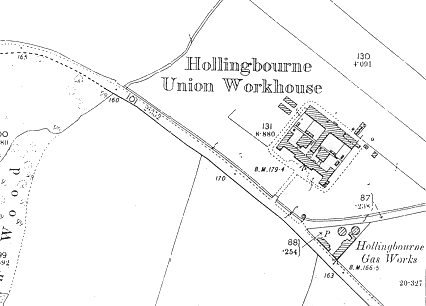
Hollingbourne site, 1895
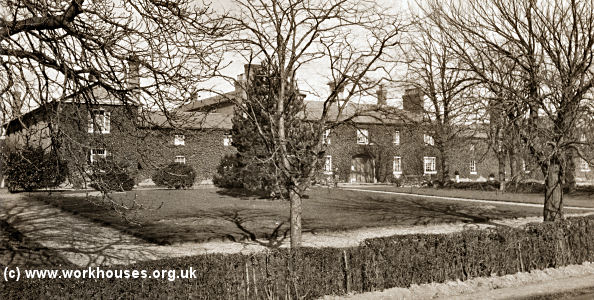
Hollingbourne workhouse from the west, c.1920.
© Peter Higginbotham.
The workhouse closed in around 1921 and the buildings demolished with the exception of the 1895 mortuary which still stands in the grounds of the property, now known as White Heath.
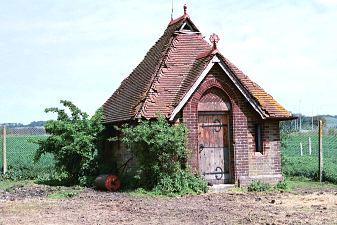
Hollingbourne workhouse mortuary from the south-west, 2001.
© Peter Higginbotham.
Staff
Inmates
Records
Note: many repositories impose a closure period of up to 100 years for records identifying individuals. Before travelling a long distance, always check that the records you want to consult will be available.
- Kent History and Library Centre, James Whatman Way, Maidstone, Kent ME14 1LQ Holdings include: Guardians' minutes (1848-1930); Births (1866-1920); Deaths (1866-1921); Creed registers (1914-21); etc.
- Canterbury Cathedral Archives, The Precincts, Canterbury, Kent CT1 2EH. Baptisms (1837-76).
Bibliography
- Higginbotham, Peter Workhouses of London and the South East (2019)
- Hitchcock, T.V. (1985) The English workhouse: a study in institutional poor relief in selected counties. l695-l750. (DPhil thesis. University of Oxford.)
Links
- None.
Acknowledgment
- Thanks to Martin Dale for the picture of the former Detling workhouse where he grew up.
Unless otherwise indicated, this page () is copyright Peter Higginbotham. Contents may not be reproduced without permission.


